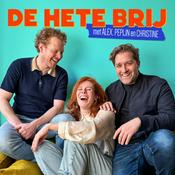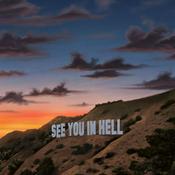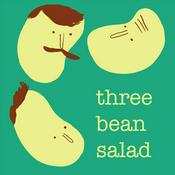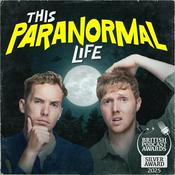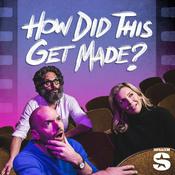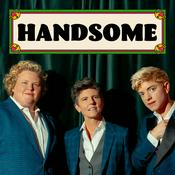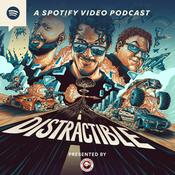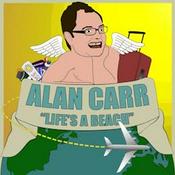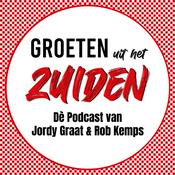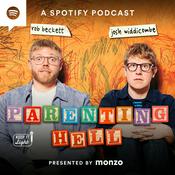98 afleveringen
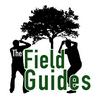
Ep. 77 - Mite-y Cool: The Amazing, Unseen World of Feather Mites
01-11-2025
In this episode, Bill and Steve dive into a tiny, bustling world - a world that’s hiding on the feathers of the birds we see every day. Joining them is Dr. Alix Matthews, postdoctoral research associate in the Department of Biological Sciences at the University at Buffalo, and she reveals the strange lives of feather mites — how these barely-visible hitchhikers feed and get around and whether or not they’re helping or hurting their avian hosts.This episode was recorded on September 4, 2025 at Walton Woods in Amherst, NY.Episode Notes and LinksCheck out Dr. Matthews’s website and research here.And watch a presentation on mites she did for Audubon Arkansas in October 2025.Sponsors and Ways to Support UsGumleaf Boots, USA (free shipping for patrons)Thank you to Always Wandering Art (Website and Etsy Shop) for providing the artwork for many of our episodes.Support us on Patreon.Check out the Field Guides merch at our Teespring store. It’s really a great deal: you get to pay us to turn your body into a billboard for the podcast!Photo CreditDr. Alix Matthews - https://matthewsalix.weebly.com/feather-mites.html

Ep. 76 - The Insect Apocalypse! (Part 2)
15-10-2025 | 1 u. 1 Min.
It’s part 2 of our dive into the Insect Apocalypse, with our good friend Dr. Jason Dombroskie from the Cornell University Insect Collection!In this part, Jason fills us in on the drivers of the Insect Apocalypse and - most importantly - what we can do about it.This episode was recorded on August 21, 2025 at Rattlesnake Hill Wildlife Management Area in Dalton, NY.. Episode NotesDuring the episode, we made the claim that 40 million acres of the US is lawn, and that that area is equal to all of the country’s National Parks put together. True? Well, sort of. The claim that the U.S. has about 40 million acres of lawn—roughly equal to all our national parks combined—is only partly true. A NASA-funded study led by Cristina Milesi estimated that turfgrass covers about 128,000 km² (≈31 million acres) of the continental U.S., making it the largest irrigated “crop” in the country (Milesi et al., Environmental Management, 2005; NASA Earth Observatory). Later analyses and popular summaries often round that up to ≈40 million acres (e.g., Scienceline, 2011; LawnStarter, 2023). By comparison, the total land area of all officially designated U.S. National Parks is about 52.4 million acres, while the entire National Park System—which also includes monuments, preserves, and historic sites—covers about 85 million acres (National Park Service, 2024). So while lawns and parks occupy areas of similar magnitude, lawns do not actually equal or exceed the combined area of the national parks. Is it better to mulch leaves on your lawn or leave them be? Here’s what we found: It’s generally best to mulch your leaves with a mower rather than rake or remove them. Research from Michigan State University found that mowing leaves into small pieces allows them to decompose quickly, returning nutrients to the soil and reducing weeds like dandelions and crabgrass (MSU Extension, “Don’t rake leaves — mulch them into your lawn”, 2012). Cornell University studies similarly show that mulched leaves improve soil structure, moisture retention, and microbial activity (Cornell Cooperative Extension, “Leaf Mulching: A Sustainable Alternative”, 2019). However, in garden beds, wooded edges, or under shrubs, it’s often better to leave leaves whole, since they provide winter habitat for butterflies, bees, and other invertebrates that overwinter in leaf litter (National Wildlife Federation, “Leave the Leaves for Wildlife”, 2020). The ideal approach is a mix: mow-mulch leaves on grassy areas for turf health and leave them intact where they naturally fall to support biodiversity and soil ecology. Episode LinksThe Cornell University Insect Collection Also, check out their great Instagram feedAnd their annual October event InsectapaloozaFind out more about the recently discovered species of Swallowtail, Papilio solstitius, commonly known as the Midsummer Tiger Swallowtail- https://www.sci.news/biology/papilio-solstitius-13710.htmlSponsors and Ways to Support UsThank you to Always Wandering Art (Website and Etsy Shop) for providing the artwork for many of our episodes.Support us on Patreon.Works CitedBiesmeijer, J.C., Roberts, S.P., Reemer, M., Ohlemuller, R., Edwards, M., Peeters, T., Schaffers, A.P., Potts, S.G., Kleukers, R.J.M.C., Thomas, C.D. and Settele, J., 2006. Parallel declines in pollinators and insect-pollinated plants in Britain and the Netherlands. Science, 313(5785), pp.351-354. Boyle, M.J., Bonebrake, T.C., Dias da Silva, K., Dongmo, M.A., Machado França, F., Gregory, N., Kitching, R.L., Ledger, M.J., Lewis, O.T., Sharp, A.C. and Stork, N.E., 2025. Causes and consequences of insect decline in tropical forests. Nature Reviews Biodiversity, pp.1-17. Burghardt, K.T., Tallamy, D.W., Philips, C. and Shropshire, K.J., 2010. Non‐native plants reduce abundance, richness, and host specialization in lepidopteran communities. Ecosphere, 1(5), pp.1-22. Colla, S.R. and Packer, L., 2008. Evidence for decline in eastern North American bumblebees (Hymenoptera: Apidae), with special focus on Bombus affinis Cresson. Biodiversity and Conservation, 17(6), pp.1379-1391. Crossley, M.S., Meier, A.R., Baldwin, E.M., Berry, L.L., Crenshaw, L.C., Hartman, G.L., Lagos-Kutz, D., Nichols, D.H., Patel, K., Varriano, S. and Snyder, W.E., 2020. No net insect abundance and diversity declines across US Long Term Ecological Research sites. Nature Ecology & Evolution, 4(10), pp.1368-1376. DeWalt, R.E., Favret, C. and Webb, D.W., 2005. Just how imperiled are aquatic insects? A case study of stoneflies (Plecoptera) in Illinois. Annals of the Entomological Society of America, 98(6), pp.941-950. Edwards, C.B., Zipkin, E.F., Henry, E.H., Haddad, N.M., Forister, M.L., Burls, K.J., Campbell, S.P., Crone, E.E., Diffendorfer, J., Douglas, M.R. and Drum, R.G., 2025. Rapid butterfly declines across the United States during the 21st century. Science, 387(6738), pp.1090-1094. Gaona, F.P., Iñiguez-Armijos, C., Brehm, G., Fiedler, K. and Espinosa, C.I., 2021. Drastic loss of insects (Lepidoptera: Geometridae) in urban landscapes in a tropical biodiversity hotspot. Journal of Insect Conservation, 25(3), pp.395-405. Gardiner, M.M., Allee, L.L., Brown, P.M., Losey, J.E., Roy, H.E. and Smyth, R.R., 2012. Lessons from lady beetles: accuracy of monitoring data from US and UK citizen‐science programs. Frontiers in Ecology and the Environment, 10(9), pp.471-476. Groenendijk, D. and van der Meulen, J., 2004. Conservation of moths in The Netherlands: population trends, distribution patterns and monitoring techniques of day-flying moths. Journal of Insect Conservation, 8(2), pp.109-118. Haddad, N.M., Haarstad, J. and Tilman, D., 2000. The effects of long-term nitrogen loading on grassland insect communities. Oecologia, 124(1), pp.73-84. Hallmann, C.A., Sorg, M., Jongejans, E., Siepel, H., Hofland, N., Schwan, H., Stenmans, W., Müller, A., Sumser, H., Hörren, T. and Goulson, D., 2017. More than 75 percent decline over 27 years in total flying insect biomass in protected areas. PLoS ONE12 (10): e0185809 Hallmann, C.A., Ssymank, A., Sorg, M., de Kroon, H. and Jongejans, E., 2021. Insect biomass decline scaled to species diversity: General patterns derived from a hoverfly community. Proceedings of the National Academy of Sciences, 118(2), p.e2002554117. Harris, J.E., Rodenhouse, N.L. and Holmes, R.T., 2019. Decline in beetle abundance and diversity in an intact temperate forest linked to climate warming. Biological Conservation, 240, p.108219. Hembry, D.H., 2013. Herbarium Specimens Reveal Putative Insect Extinction on the Deforested Island of Mangareva (Gambier Archipelago, French Polynesia). Pacific Science, 67(4), pp.553-560. Høye, T.T., Loboda, S., Koltz, A.M., Gillespie, M.A., Bowden, J.J. and Schmidt, N.M., 2021. Nonlinear trends in abundance and diversity and complex responses to climate change in Arctic arthropods. Proceedings of the National Academy of Sciences, 118(2), p.e2002557117. Huryn, A.D. and Wallace, J.B., 2000. Life history and production of stream insects. Annual review of entomology, 45(1), pp.83-110. Kawahara, A.Y., Reeves, L.E., Barber, J.R. and Black, S.H., 2021. Eight simple actions that individuals can take to save insects from global declines. Proceedings of the National Academy of Sciences, 118(2), p.e2002547117. Leuenberger, W., Doser, J.W., Belitz, M.W., Ries, L., Haddad, N.M., Thogmartin, W.E. and Zipkin, E.F., 2025. Three decades of declines restructure butterfly communities in the Midwestern United States. Proceedings of the National Academy of Sciences, 122(33), p.e2501340122. Liang, M., Yang, Q., Chase, J.M., Isbell, F., Loreau, M., Schmid, B., Seabloom, E.W., Tilman, D. and Wang, S., 2025. Unifying spatial scaling laws of biodiversity and ecosystem stability. Science, 387(6740), p.eadl2373. Lister, B.C. and Garcia, A., 2018. Climate-driven declines in arthropod abundance restructure a rainforest food web. Proceedings of the National Academy of Sciences, 115(44), pp.E10397-E10406. Owens, A.C., Pocock, M.J. and Seymoure, B.M., 2024. Current evidence in support of insect-friendly lighting practices. Current Opinion in Insect Science, 66, p.101276. Myers, L.W., Kondratieff, B.C., Grubbs, S.A., Pett, L.A., DeWalt, R.E., Mihuc, T.B. and Hart, L.V., 2025. Distributional and species richness patterns of the stoneflies (Insecta, Plecoptera) in New York State. Biodiversity Data Journal, 13, p.e158952. Pilotto, F., Kühn, I., Adrian, R., Alber, R., Alignier, A., Andrews, C., Bäck, J., Barbaro, L., Beaumont, D., Beenaerts, N. and Benham, S., 2020. Meta-analysis of multidecadal biodiversity trends in Europe. Nature communications, 11(1), p.3486. Pinkert, S., Farwig, N., Kawahara, A.Y. and Jetz, W., 2025. Global hotspots of butterfly diversity are threatened in a warming world. Nature Ecology & Evolution, pp.1-12. Raven, P.H. and Wagner, D.L., 2021. Agricultural intensification and climate change are rapidly decreasing insect biodiversity. Proceedings of the National Academy of Sciences, 118(2), p.e2002548117. Rodrigues, A.V., Rissanen, T., Jones, M.M., Huikkonen, I.M., Huitu, O., Korpimäki, E., Kuussaari, M., Lehikoinen, A., Lindén, A., Pietiäinen, H. and Pöyry, J., 2025. Cross‐Taxa Analysis of Long‐Term Data Reveals a Positive Biodiversity‐Stability Relationship With Taxon‐Specific Mechanistic Underpinning. Ecology Letters, 28(4), p.e70003. Salcido, D.M., Forister, M.L., Garcia Lopez, H. and Dyer, L.A., 2020. Loss of dominant caterpillar genera in a protected tropical forest. Scientific reports, 10(1), p.422. Sánchez-Bayo, F. and Wyckhuys, K.A., 2019. Worldwide decline of the entomofauna: A review of its drivers. Biological conservation, 232, pp.8-27. Schowalter, T.D., Pandey, M., Presley, S.J., Willig, M.R. and Zimmerman, J.K., 2021. Arthropods are not declining but are responsive to disturbance in the Luquillo Experimental Forest, Puerto Rico. Proceedings of the National Academy of Sciences, 118(2), p.e2002556117. Sedlmeier, J.E., Grass, I., Bendalam, P., Höglinger, B., Walker, F., Gerhard, D., Piepho, H.P., Brühl, C.A. and Petschenka, G., 2025. Neonicotinoid insecticides can pose a severe threat to grassland plant bug communities. Communications Earth & Environment, 6(1), p.162. Shortall, C.R., Moore, A., Smith, E., Hall, M.J., Woiwod, I.P. and Harrington, R., 2009. Long‐term changes in the abundance of flying insects. Insect Conservation and Diversity, 2(4), pp.251-260. Soga, M. and Gaston, K.J., 2018. Shifting baseline syndrome: causes, consequences, and implications. Frontiers in Ecology and the Environment, 16(4), pp.222-230. Stork, N.E., 2018. How many species of insects and other terrestrial arthropods are there on Earth?. Annual review of entomology, 63(2018), pp.31-45. Tallamy, D.W., Narango, D.L. and Mitchell, A.B., 2021. Do non‐native plants contribute to insect declines?. Ecological Entomology, 46(4), pp.729-742. Thomas, J.A., Telfer, M.G., Roy, D.B., Preston, C.D., Greenwood, J.J.D., Asher, J., Fox, R., Clarke, R.T. and Lawton, J.H., 2004. Comparative losses of British butterflies, birds, and plants and the global extinction crisis. Science, 303(5665), pp.1879-1881. Tierno de Figueroa, J.M., López-Rodríguez, M.J., Lorenz, A., Graf, W., Schmidt-Kloiber, A. and Hering, D., 2010. Vulnerable taxa of European Plecoptera (Insecta) in the context of climate change. Biodiversity and conservation, 19(5), pp.1269-1277. Turin, H. and Den Boer, P.J., 1988. Changes in the distribution of carabid beetles in The Netherlands since 1880. II. Isolation of habitats and long-term time trends in the occurence of carabid species with different powers of dispersal (Coleoptera, Carabidae). Biological Conservation, 44(3), pp.179-200. Van Deynze, B., Swinton, S.M., Hennessy, D.A., Haddad, N.M. and Ries, L., 2024. Insecticides, more than herbicides, land use, and climate, are associated with declines in butterfly species richness and abundance in the American Midwest. PLoS One, 19(6), p.e0304319. Van Klink, R., Bowler, D.E., Gongalsky, K.B., Swengel, A.B., Gentile, A. and Chase, J.M., 2020. Meta-analysis reveals declines in terrestrial but increases in freshwater insect abundances. Science, 368(6489), pp.417-420. Wagner, D.L., Fox, R., Salcido, D.M. and Dyer, L.A., 2021. A window to the world of global insect declines: Moth biodiversity trends are complex and heterogeneous. Proceedings of the National Academy of Sciences, 118(2), p.e2002549117. Wagner DL, Grames EM, Forister ML, Berenbaum MR, Stopak D. Insect decline in the Anthropocene: Death by a thousand cuts. Proceedings of the National Academy of Sciences. 2021 Jan 12;118(2):e2023989118. WallisDeVries, M.F. and van Swaay, C.A., 2017. A nitrogen index to track changes in butterfly species assemblages under nitrogen deposition. Biological Conservation, 212, pp.448-453. Warren, M.S., Hill, J.K., Thomas, J.A., Asher, J., Fox, R., Huntley, B., Roy, D.B., Telfer, M.G., Jeffcoate, S., Harding, P. and Jeffcoate, G., 2001. Rapid responses of British butterflies to opposing forces of climate and habitat change. Nature, 414(6859), pp.65-69. Warren, M.S., Maes, D., van Swaay, C.A., Goffart, P., Van Dyck, H., Bourn, N.A., Wynhoff, I., Hoare, D. and Ellis, S., 2021. The decline of butterflies in Europe: Problems, significance, and possible solutions. Proceedings of the National Academy of Sciences, 118(2), p.e2002551117. Wilson, E.O., 1987. The little things that run the world (the importance and conservation of invertebrates). Conservation biology, pp.344-346. Yang, L.H. and Gratton, C., 2014. Insects as drivers of ecosystem processes. Current opinion in insect science, 2, pp.26-32.Visit thefieldguidespodcast.com for full episode notes, links, and works cited.

Ep. 76 - The Insect Apocalypse! (Part 1)
30-9-2025 | 56 Min.
The guys are back in the field with our good friend Dr. Jason Dombroskie from the Cornell University Insect Collection!Listen in as Jason leads us through fields and forests, trusty butterfly net in hand, filling us in on the so-called “Insect Apocalypse.” Are insect populations really collapsing worldwide? What do the numbers say? How bad is it, and — most importantly — what can we do about it?In this part, we head out on the trail with Jason. He introduces us to some insects we find along the way and schools us on why insects are so important, and in part two – he delves into the details of the insect apocalypse – what we know and what we don’t know. And since we feel bad that you can’t see what we got to see – we bring back a little trick we had in our last episodes with Jason – each time we find a critter listen for the sound of a camera shutter. That’s the signal to visit this episode’s page on our website – thefieldguidespodcast.com - we’ll have photos there timestamped so you can see what we’re looking at, along with some extra info. Enjoy…This episode was recorded on August 21, 2025 at Rattlesnake Hill Wildlife Management Area in Dalton, NY.. Episode NotesSteve said he heard that there are more species of just weevils than there are of fish. Is that true? At one point in the episode Steve mentioned he’d heard there are more species of weevils than there are of fish. I looked it up, and he’s right! Scientists have described around 60–70,000 weevil species, with the real total likely over 100,000, while all the fish in the world come in at about 35,000 species. So as surprising as it sounds, Steve’s claim checks out—the humble weevil family really does outnumber all the fish.It was also mentioned that some insects are only known from a single specimen in a collection and have never been seen again in the wild. We looked for a study and found a large one from 2018 that looked at more than 800,000 insect species – it found that about one in five—around 19%—are described from a single specimen and never collected again (Lim et al., Current Biology, 2018). It really shows how much of insect diversity is still barely known.Pollard Walk - During the episode Bill asked about something called a Pollard Walk. That’s actually a standard insect survey method. The idea is simple: you walk a fixed route—usually the same path each time—at a steady pace and record every insect you see within a certain distance, often about 2.5 meters on each side. It’s kind of like a birding “point count,” but moving. The method, named after Eric Pollard who developed it in the 1970s for butterfly monitoring, is still one of the most widely used ways scientists track insect populations over time.Visit thefieldguidespodcast.com for full episode notes, links, and works cited.

Ep. 75 - A Naturalist's Life (Part 2) - A "Hike" with Sandy Geffner
15-9-2025 | 42 Min.
Part 2 of our time in the woods with naturalist Sandy Geffner. This time, Sandy leads Steve and Bill on a “hike”—though with Sandy, the word takes on a different meaning. You might not cover much distance, but you’ll travel miles in understanding: exploring ecology and hearing stories of the forest and the wildlife within it. Enjoy!This episode was recorded on July 21, 2025 at JP Nicely Memorial Park in West Falls, NY.Episode Notes and LinksSandy’s favorite books: A Sand County Almanac by Aldo Leopold and Finding the Mother Tree by Suzanne Simard. But we feel that we have to call ourselves out here because we’ve been critical of Simard’s work before and maybe we should’ve brought this up with Sandy during the episode (but we obviously didn’t have the stones). For a deep dive into some of the criticisms of Simard’s word, check out the In Defense of Plants podcast’s series of episodes that starts here. Or this article by three professors who’ve spent their careers studying forest fungi. Sponsors and Ways to Support UsThank you to Always Wandering Art (Website and Etsy Shop) for providing the artwork for many of our episodes.Support us on Patreon.Photo CreditThe Natural Side of UB by Robby Johnson

Ep. 75 - A Naturalist's Life (Part 1) - A Conversation with Sandy Geffner
31-8-2025 | 1 u. 5 Min.
What exactly is a “naturalist”? Spend a little time with Sandy Geffner, and you’ll find out. Steve and Bill rarely go more than an episode or two without mentioning him—a naturalist who profoundly shaped both their lives. This month, they head into the woods to talk with Sandy about how a baseball-loving kid from Long Island became someone who’s inspired countless people to deepen their connection with the natural world.This episode was recorded on July 21, 2025 at JP Nicely Memorial Park in West Falls, NY.Episode Notes and LinksEarth Spirit Educational Services Rogers Environmental CenterThe State University of NY at Buffalo’s Dept. of Environment and SustainabilitySandy’s UB Faculty PageSantee Sioux ReservationStony Kill Farm Environmental Education CenterTifft Nature PreserveCayuga Nature Center / TreetopsSponsors and Ways to Support UsThank you to Always Wandering Art (Website and Etsy Shop) for providing the artwork for many of our episodes.Support us on Patreon.Photo CreditSUNY at Buffalo
Meer Komedie podcasts
Trending Komedie -podcasts
Over The Field Guides
Luister naar The Field Guides, Wat een Week! en vele andere podcasts van over de hele wereld met de radio.net-app

Ontvang de gratis radio.net app
- Zenders en podcasts om te bookmarken
- Streamen via Wi-Fi of Bluetooth
- Ondersteunt Carplay & Android Auto
- Veel andere app-functies
Ontvang de gratis radio.net app
- Zenders en podcasts om te bookmarken
- Streamen via Wi-Fi of Bluetooth
- Ondersteunt Carplay & Android Auto
- Veel andere app-functies


The Field Guides
download de app,
luisteren.




